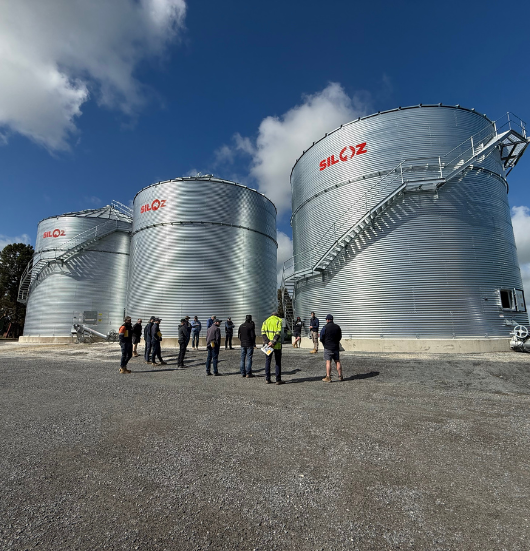Pre-harvest grain storage
This blog discusses grain storage hygiene, prevention of insects and pre-harvest checks.

Key messages
- Hygiene is key – clean thoroughly and dispose of any old grain
- Use structural treatment, diatomaceous earth (DE), ensure no insects are present in empty storage prior to harvest
- Choose protectants based on grain type and plan for marketing.
- Temperature reduction in grain through aeration cooling significantly improves storage conditions and prolongs grain quality.
With harvest just around the corner, now is the time to make sure your grain storage is ready. Clean silos and sound infrastructure can make the difference between capturing premiums or losing value through pests, moisture issues, or quality downgrades.
Here are some pre-harvest checks and practical tips to get your storage system harvest-ready.
Start with hygiene
Protecting grain in storage begins well before you harvest it. To give yourself the best start in storage ensure you:
- Clean out silos, field bins and augers - vacuum or sweep out.
- Remove old grain from sheds, pad and around silos.
- Clean harvesting equipment - straight after harvest is the best time to clean equipment however cleaning prior to harvest and selling the first load of grain off farm is also useful.
- Dispose of sweepings properly - do not just put in a drum or pile to deal with later, as this is just moving the breeding ground from one place to another (and the insects will find their way back into your silo or shed).
Did you know: One bag of infested grain can produce more than one million insects during a year. These can walk or fly to other grain storage sites and will start new infestations.’
Structural treatment
Diatomaceous earth (DE) (amorphous silica), includes commercial brands such as Dryacide, can be applied either as a dust or a slurry to treat storages and handling equipment for residual control.
Diatomaceous earth requires a moving air-stream to direct it onto the surface being treated. To apply use a venturi duster such as the Blovac BV-22 for an efficient job. Another option is to use a battery or petrol leaf blower, trickling the DE into the air stream as it exits the blower.
(GRDC GrowNotes Grain Storage page 51 for in-depth instructions)
Protectants
A particularly useful tool in the tool belt, alongside hygiene and aeration cooling, when grain is being stored in unsealable storage.
Things to think about before making your choice of protectant:
- The protectant you are going to apply is registered for the grain you wish to apply it to and that it will be effective against the insects you most commonly find in your storage.
- Chemistry should be rotated to prevent build-up of resistance.
- Always check the intended grain buyer/market accepts grain treated with the protectant you chose.
- See the protectant choice guide below (Source: GRDC GrowNotes Grain Storage page 54)

Watch this video on protectant choices:
Effect of grain temperature on storage pest activity
Aim to cool grain quickly to reduce attractiveness to pests as a habitat and slow down their breeding cycle. At cool temperatures insect pest life cycles (egg, larvae, pupae and adult) are extended from the typical four weeks at warm temperatures (30–35°C) to 12–17 weeks life cycles at cooler temperatures (20–23°C). While adult insects can still survive at cool temperatures, young insects stop developing at temperatures below 18–20°C. At temperatures below 15°C weevils stop developing and most insects stop reproducing.

Temperature and moisture also significantly affect grain germination so, if possible, harvest seed grain in the cooler parts of the day, and ensure the moisture is below 12%.

More information on seed temperature and germination -GRDC Groundcover: Seeds need cool, dry conditions, no matter the variety
Aeration cooling
If you have aeration systems make sure they are serviced prior to harvest.
Aeration is one of the most effective ways to protect grain. Pre-harvest is the time to make sure fans and controllers are working properly. Air flow should be 2-4 litres per second per tonne.
Pre-harvest checks:
- Test run fans to make sure motors, wiring and switches are safe.
- Check ducts and vents for blockages.
- Confirm automatic controllers are switching on at the right times (cool, dry air).
Safety and access
Harvest is busy – don’t leave safety checks to the last minute.
- Inspect silo ladders, platforms and guards.
- Ensure augers and conveyors have working safety shields.
- Clear areas around silos and grain pads for easy truck access.
Marketing considerations
Before you fill a silo, think about where that grain is headed.
- Segregrate by quality - protein, moisture, screenings & test weight all matter.
- Plan storage space by crop – e.g. keeping malting barley separate from feed barley.
- Factor in contracts - having grain available later can capture premiums, but only if quality is protected.
Pre- harvest checklist
- Silos/sheds/machinery cleaned
- Structural treatment applied
- Aeration fans tested and working
- Safety checks completed
- Marketing & protectant plan in place
Don’t forget if you have any questions, you can contact the GRDC stored grain extension team email, info@storedgrain.com.au or and phone number, 1800WEEVIL.
More resources
GRDC Stored Grain protectant choices
GRDC podcast: Pre-harvest prep protecting stored grain
GRDC Research update online: Pre-harvest grain storage health check
GRDC GroundCover: Give grain storage a pre-harvest health check
Author
Lynn Macaulay
Member Engagement Officer Bachelor of Agriculture and Farm Business Management
14 October 2025
NEWS
Keep up to date with what's happening across the Riverine Plains.
-
Livestock
-
People
-
Sustainability

